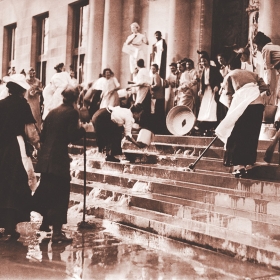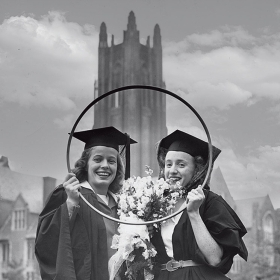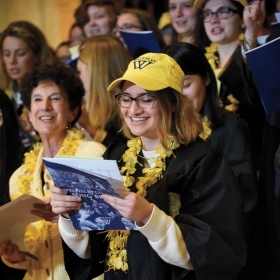If you’ve heard of the old May Day festivities, it’s probably because Hooprolling and, later, Stepsinging, took place as part of the celebrations. But over the decades, May Day fell away, along with one of its quirkier traditions: scrubbing campus statues and steps.

Wellesley seniors scrub the library steps during a May Day celebration after the College Hall fire, date unknown.
If you’ve heard of the old May Day festivities at the College, it’s probably because Hooprolling and, later, Stepsinging, took place as part of the celebrations. But over the decades, May Day fell away, along with one of its quirkier traditions: scrubbing campus statues and steps.
In the College’s early days, “The Backwoodsman,” a naturalistic statue of a man with a raised axe, stood on the South Porch of College Hall. Students initially disliked the statue, but by the turn of the century, it achieved a kind of celebrity status on campus. Students incorporated the statue into May Day celebrations, washing and decorating it along with other statues inside College Hall. Sophomore Mary Rosa, class of 1914, wrote to her parents in 1911: “Yesterday was May Day! Such a long busy day too. … In the morning the freshmen assembled at East Lodge at six-fifteen and marched up to College Hall with our May-Basket. We found the Seniors scrubbing the Backwoodsman statue on the South Porch, a yearly performance. After that we all went inside to inspect the other statues, which had all been dressed up for the occasion. … Until eight o’clock we sat down by the lake. Then the seniors, in cap and gown, formed in line and childishly rolled their hoops down to the chapel, provoking much merriment.”
After the College Hall fire of 1914, the May Day scrubbing ritual moved over the years to the new Tower Court steps, the chapel steps, and the library steps, as shown above, likely sometime in the nineteen-teens. According to Barbara Philippa McCarthy, Ellen A. Kendall Professor of Greek at Wellesley until 1970, who wrote the “Traditions” chapter in Wellesley College 1875–1975: A Century of Women, the class of 1923 “wisely voted to abandon the scrubbing as ‘of no present significance.’” The class of 1960 attempted to revive the tradition their junior year and scrubbed the chapel steps with toothbrushes, but it didn’t take—scrubbing was officially washed up.


